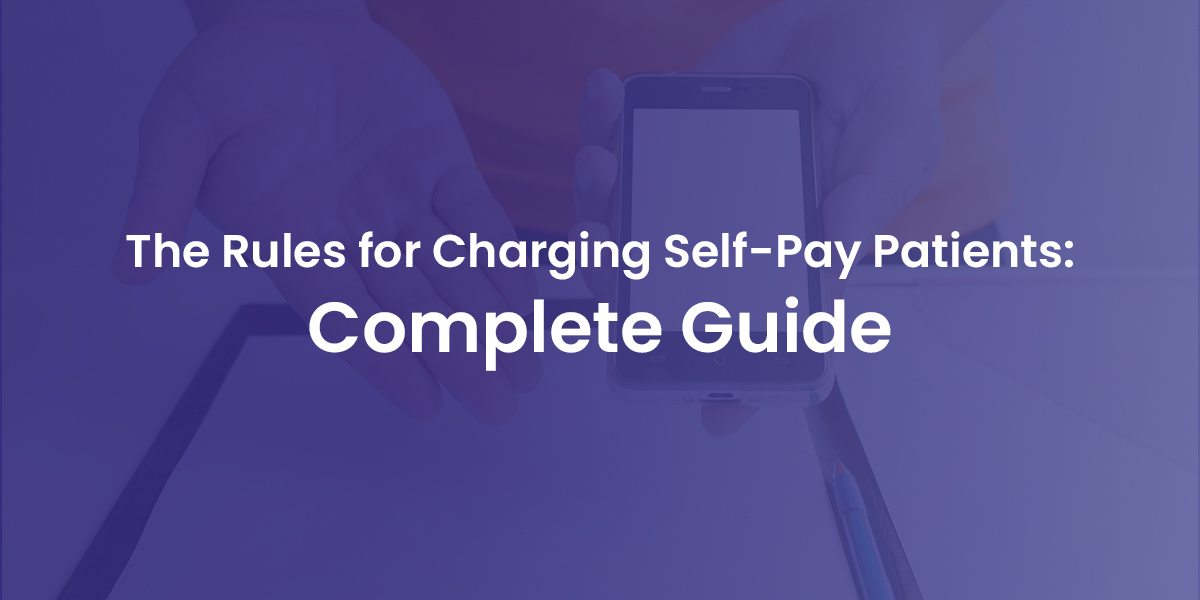You may be running a clinic or working as a physician in a hospital anywhere in the USA. In that case, you know that the patients get insurance on the medical services they receive from any provider. But in some cases, you may have experienced patients visiting you without insurance plans for their treatments.
Hence, we can categorize the patients as:
- Insured Patients (patients relying on insurance providers)
- Uninsured Patients or Self-Pay Patients
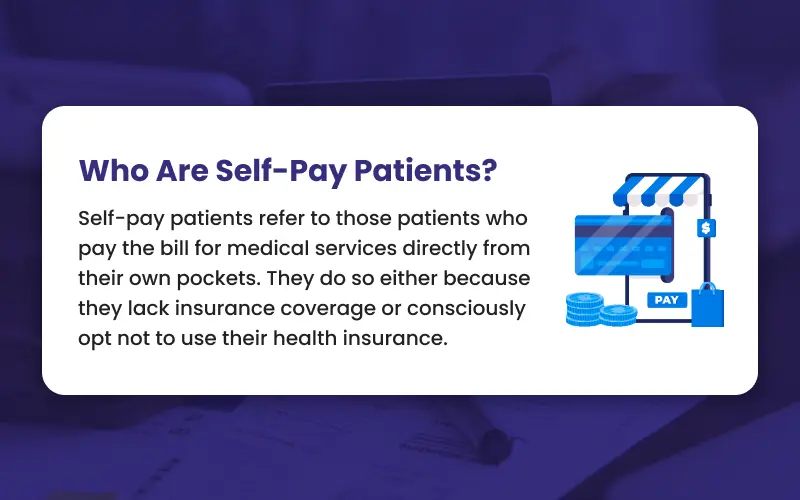
Who Are Self-Pay Patients?
SELF-PAY PATIENTS refer to those patients who pay the bill for medical services directly from their own pockets. They do so either because they lack insurance coverage or consciously opt not to use their health insurance. These individuals are not part of any particular plan, coverage, or Federal health care program, making them what we call uninsured patients. This patient group includes not only those without insurance but also those with high-deductible plans, as well as those seeking services that fall outside the scope of their insurance coverage.
Optimizing the revenue cycle is vital for your practice, whether dealing with insured or self-pay patients.
In the case of self-pay patients, the billing management can be more difficult.
This is because…
without the structure of insurance claims and negotiated rates, the onus falls more heavily on the provider to handle invoicing, track outstanding balances, and follow up on late payments.
Self-pay patients require clear communication upfront about payment expectations and responsibilities. Ongoing attention and diligent record-keeping is needed to prevent revenue leakage.
Patience and understanding is also required, as self-pay patients may struggle with affordability issues.
In some cases, the doctor might end up stuck following up repeatedly and setting up payment plans to hopefully get what he’s due.

Still, these patients need care like anyone else, so finding a way to make the finances work proves important for all parties involved.
Therefore, this comprehensive guide here will discuss the rules for charging self-pay patients.
The Rules for Charging Self-Pay Patients
Charging for self-pay patients can be more complex. However, medical practices and physicians must follow some proactive rules to get payments for this group of patients successfully.
Here, we will discuss the 7 essential rules for charging self-pay patients:
1). Set Up Pricing Models for Self-Pay Patients

There are a few ways to price your services for self-pay patients.
You can charge a flat fee for each visit or procedure. This is simple but may not match what other doctors in your area are charging.
You can base prices on what Medicare reimburses for the same services. This at least gives you a benchmark, but Medicare rates are often lower than private insurance.
The most flexible model is charging patients based on your own fee schedule. Set your own fair prices for exams, tests, and procedures based on your costs and what the local market will bear. Then be very clear in communicating this fee schedule to new self-pay patients.
Have a frank conversation about what services they’re likely to need and what they can expect to pay out-of-pocket. No surprises – that’s the key.
Self-pay patients want to know the precise cost of that CT scan, physical therapy session, or wellness visit. Give your charges to them straight in an easy-to-understand format before services are rendered. And be open to negotiating if a patient has a reasonable case. It’s better to charge a little less and keep the patient, than have them walk away downhearted over a bill they can’t afford.
2). Offer Multiple Payment Plans
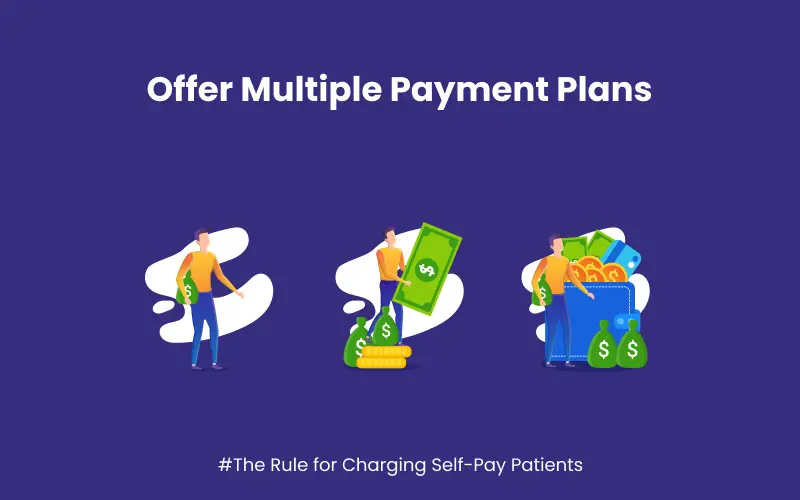
Offering multiple payment plans is the best way to charge self-pay patients. There are a few types of payment plans to consider.
➤ Extended payment plans allow patients to pay over time with fixed installments, maybe 6-24 months. This helps because medical bills can be expensive and not everyone has savings to pay upfront. Patients appreciate knowing exactly what they owe each month.
➤ Interest-free plans mean patients pay the full amount but have extra time, like 12 months, to pay with no fees. This option is good for those who can pay the bill eventually if given more time. Patients see the total due upfront so there are no surprises.
➤ Discounted pay-in-full plans give patients a percentage off, maybe 10-30%, if they pay the entire bill within 30-90 days. This motivates patients to pay quickly if they are able to. The discount is a courtesy that builds goodwill.
Payment plans help healthcare providers actually get paid. Without plans, many self-pay bills end up in collections or written off as bad debt. Plans make the billing process smoother for staff and patients. Patients see their options clearly and can choose what works for their situation.
In addition, transparent payment plans create a better experience for self-pay patients. They feel less confused and anxious about how they’ll pay. Healthcare providers build trust and loyalty by offering multiple reasonable options. And more bills actually get paid thanks to the flexibility of payment over time. It’s a win-win for patients and providers alike.
3). Provide Clear and Consistent Policies
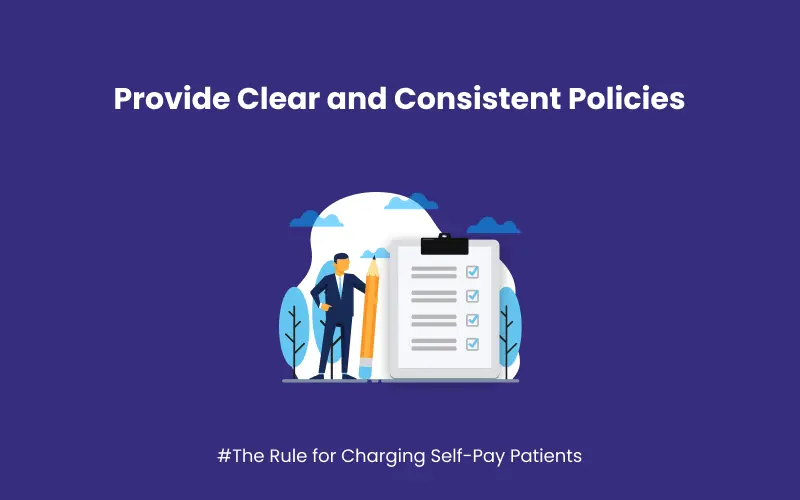
When it comes to charging self-pay patients, one of the best rules is to provide clear and consistent policies. You need to lay down some solid ground rules so uninsured patients know what to expect.
➜ First off, have a set price for common services – whether it’s a standard office visit or a routine procedure. That way patients aren’t left scratching their heads wondering what a doctor’s appointment might run them. Print out a clear fee schedule and post it where patients can see it. And if you do discount for cash payments, make sure to advertise that upfront as well.
➜ You’ll also want consistent payment policies. Decide whether you require payment upfront, at time of service, or within a set timeframe after. Then stick to it across the board. Nothing confuses and frustrates patients more than wishy-washy rules. Tell them straight and true when you expect to be paid.
➜ And have a firm policy on payment plans and financial assistance. If you’re willing to break payments into installments, great — just spell out how they work. If you offer sliding scale discounts for financial hardship, terrific — but document the criteria so it’s fair for all.
The benefits of consistent policies? For one, they build trust. Patients will know what to expect financially, which gives them confidence in you. It also avoids awkward situations where patients are blindsided by unexpected charges. And it ensures everyone is on the same page, which makes the billing process smoother for your practice.
4. Stay in Compliance with Regulations

Another best practice for charging self-pay patients is following the rules set for them.
As a doctor, you have to protect their privacy by adhering to HIPAA. You also need to bill them properly according to the Centers for Medicare and Medicaid Services. There are rules for how you charge self-pay patients in the USA, and you must know them well.
If you don’t follow the rules, you could end up in trouble legally or owe fines. And your patients won’t be too happy either if they get big surprise bills they weren’t expecting.
👉 One important aspect to consider is the avoidance of balance billing or surprise medical billing.
Balance billing occurs when a healthcare provider bills a patient for the remaining amount not covered by insurance, resulting in unexpected expenses for the patient. To prevent this, it is essential to accurately communicate the costs involved upfront and provide clear explanations of the billing process to self-pay patients. By doing so, you can avoid legal and financial penalties that may arise from improper billing practices.
5). Follow Accurate Billing Procedures for Self-Pay Patients

An ideal way to charge self-pay patients is to give them an itemized bill of the services, a full and detailed list of everything.
You see, for a self-pay patient, you can’t just use the usual codes and charges you use for the insurance companies. The insurance companies have set rates they’ll pay for everything, from a bandage to an operation, but the self-pay patient needs to know exactly what’s being charged for.
When you have a self-pay patient, you have to follow the rules for billing and coding very carefully. It’s not like when a doctor bills, where there’s a fixed charge for each little code.
With regards to a self-pay patients, what the doctor charges depends on all the things that were used, the drugs, the supplies, the meals, any special services for the uninsured patient. A lot of those things don’t even have a code, but the hospital still has to charge for them.
Say a self-pay patient has an operation. The hospital will charge based on how long the operating room was used, or how complicated the operation was. They don’t just charge a fixed rate based on the type of operation and CPT code for the procedure. They have to consider all the resources that went into it.
6). Explain Good Faith Estimates to Self-Pay Patients
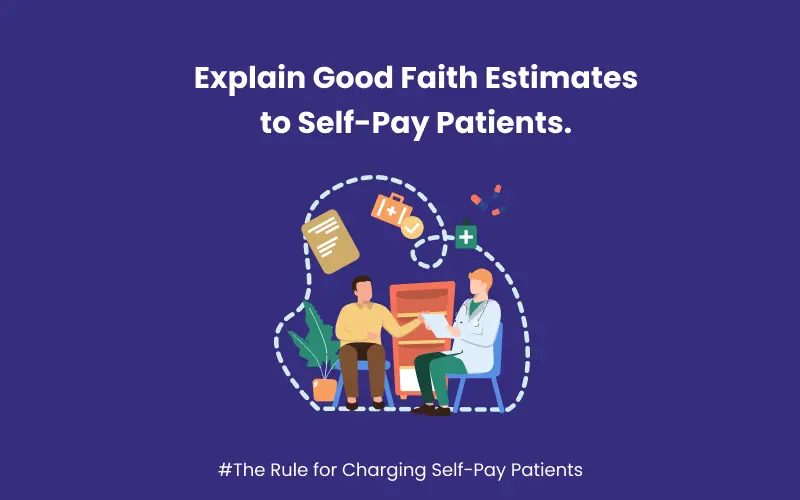
The best rule for charging self pay patients is to explain Good Faith Estimates to them upfront. Now, what exactly are Good Faith Estimates, you may ask? Essentially, they are documents that healthcare providers give patients to outline the expected costs for a medical service ahead of time. These documents list the anticipated charges for things like tests, procedures, doctor visits — you name it.
The reason it’s so important to provide Good Faith Estimates is that it allows the self pay patient to understand the financial responsibility they are taking on. Without transparency around costs, the patient may be caught unaware by a surprisingly high bill. That almost inevitably leads to confusion, frustration, and lack of trust in the provider.
Let me give you an example. Say a patient without insurance needs an MRI scan on their knee to diagnose an injury. The healthcare provider should explain that the estimated cost for that scan will be $1500, which covers the radiologist reading and equipment fees. If the patient decides to move forward knowing the MRI will cost roughly $1500 out of pocket, there won’t be any sticker shock when they receive the final bill.
😮💨 Remember: If the patient is in a federal health insurance program like Medicare or Medicaid, they don’t get a GFE because those programs have their surprise billing protections for patients.
Not only is this the ethical thing to do, but explaining Good Faith Estimates is required by law. Providers must give self pay patients a GFE for any service over $400 within 3 days of scheduling.
7). Implement Sliding Fee Scale System
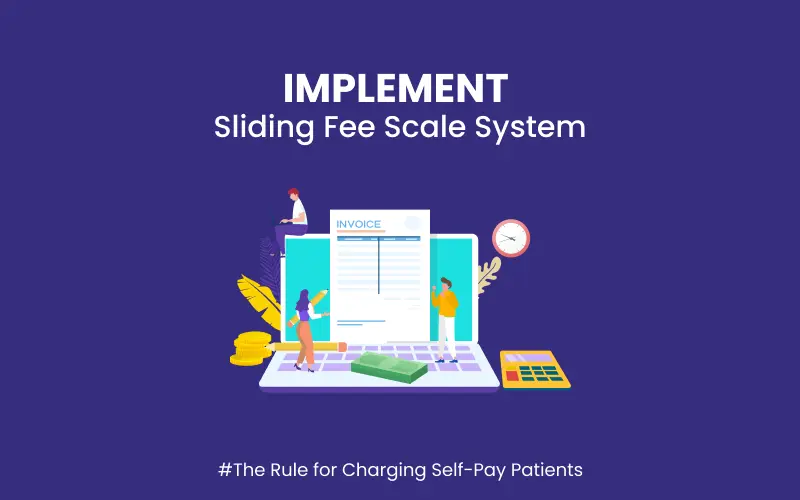
When it comes to charging those patients who pay out of their own pockets, a good approach is to set up a sliding scale system. A sliding scale system means charging folks based on what they can afford rather than a flat fee.
Now, to set up a sliding scale system for your medical practice, here is what you need to do:
1). First, determine the minimum and maximum fees you can charge for your most common services. For example, an office visit may range from $50 to $200.
2). Next, within that range, establish 3 or 4 tiers of fees based on a patient’s income and ability to pay. The lowest tier should still cover your costs. Publish your sliding scale fees so patients know what to expect.
3). When a new self-pay patient comes in, have them fill out a short form about their income and expenses. Determine which fee tier is affordable for them based on their situation. Charge them the fee for that tier. For follow up visits, you can charge them the same fee, unless their financial situation has changed significantly. In that case, you may need to adjust their tier.
A sliding scale system allows you to provide care to those in your community who need it the most. And by charging something, even at the lower end of the scale, you can still keep your doors open and the lights on. The most important thing is that people can get the care they need, not how much they pay for it. If you go about it with that attitude, a sliding scale system can be rewarding for both your patients and your practice.
Can You Bill a Self-Pay Patient Less than Medicare?
✅ In general, it’s not against the rules for a doctor to lower the fees for patients who pay out of their own pockets. But you have to be careful if you’re going to offer discounts.
First, the Medicare laws say you can’t charge Medicare patients more than your usual fees. If you give big discounts to self-pay patients while charging higher prices to Medicare-insured patients, Medicare might decide your discounted fees are really your normal fees.
The AAFP tells doctors not to give discounts of more than 30% of what they charge most patients. That way Medicare probably won’t say the discounts are your real fees.
Second, be ready to explain why you’re lowering fees for patients who are self-pay. You could say it’s less paperwork, or that they pay faster, or that some patients can’t afford the full price. If Medicare asks, have a good reason.
Overall, go slowly and be cautious. But if done right, cutting fees for cash customers is OK. Just make sure you follow the rules and keep good records showing your normal charges and the discounts. And don’t get carried away – stick to small discounts, at least at first. If you start too big, it could lead to headaches down the road. But for the right patient, trimming a little off the bill out of goodwill can go a long way.
Best Strategies To Avoid Payment Problems with Self-Pay Patients
The first step in collecting what your self-pay patients owe you is to have a formal, written payment policy. The purpose is to make sure everyone understands it’s ultimately the patient’s responsibility (or the guardian’s or caregiver’s, for dependent people) to pay for your services.
On top of that, any proper payment policy should lay out these things:
➜ Communicate your payment policy to the patient.
For patients paying out of their own pockets, it’s best to be upfront about the payment policy.
As a doctor, you should tell them clearly that the fees for your services need to be paid the same day, unless you both agree in writing to a different plan ahead of time. This avoids confusion and ensures you get paid properly for your work. It benefits the patient too, as they know exactly what to expect financially.
For example, if a self-pay patient comes to see you, you could say something like:
“I want to be upfront that my services today will be $125, due at the time of your visit. We’re happy to set up an installment plan if needed, but we must establish that in writing before your appointment.”
An honest discussion about money may be uncomfortable for some providers (I mean the introvert ones 😜), but for self-pay patients, knowing what to expect financially is half the battle.
In addition, it’s important to spread the word in the office too. Put up copies of the policy. Have copies at the front desk for patients. When a new patient comes in, have a staff member walk through your rules, including payment. Once you’re sure they get it and agree, have them sign.
➜ Negotiate how much the patient will pay you upfront and then later on as installments.
For those patients who haven’t signed up with healthcare insurance plans, it’s important to communicate clearly that they will be responsible for paying the full amount of their bills.
Similarly, patients with health plans need to be aware that they will be responsible for any expenses not covered by their plans. Whether it’s a portion of the bill or the entire cost, they need to be prepared to pay the remaining amount.
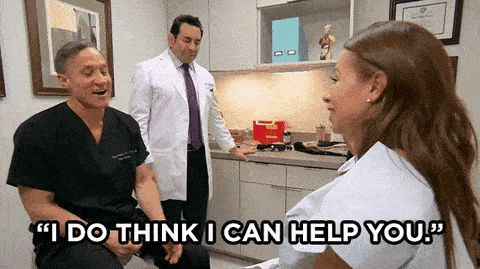
Providers may consider offering flexible payment options to accommodate patients’ financial situations. This could include setting up installment plans or discussing alternative arrangements that make it easier for patients to fulfill their financial obligations.
Now, let’s discuss the technical side of implementing these payment policies as a healthcare provider. Firstly, make sure to have well-documented billing procedures in place. This includes outlining the payment terms and expectations for both self pay patients and those with health plans. It’s also important to have patients sign agreements or contracts, acknowledging their understanding and agreement to the payment terms.
➜ Define your acceptable payment modes – cash, card, or check.
As a doctor, getting paid is half the battle when dealing with self-pay patients. The best approach is to have a simple yet comprehensive payment policy stating the acceptable methods, like cash, checks, and credit cards.
Checks can be risky if not verified. Bogus checks are common from fraudsters, so call the bank to confirm funds before treatment.
To avoid check fraud altogether, cash or card is best. In my experience, plastic is the most convenient for patients and practice alike. The fees are nominal, and payment is guaranteed.
For patients writing a check, have them wait while you phone the bank. If the funds aren’t there, have them pay another way or reschedule their appointment. No sense in providing service without payment.
➜ Have your patients sign a promissory note.
Sometimes patients just can’t afford to pay for their medical care all at once. As a doc, you still want to help them, but you need to get paid for your services too. The best way to handle this with self-pay patients is to have them sign what we call a promissory note before treating them.
A promissory note is a written promise to pay. It lays out how much they owe, when payments are due and how much needs to be paid each time.
You want to be real clear on the details. Sit down with the patient and work out a payment plan you’re both comfortable with. Make sure they understand when payments are expected and that they intend to pay as agreed. Have them sign the note to seal the deal.
If you establish regular due dates and fixed amounts, it’s more likely you’ll get paid. The key is making sure that patient understands and accepts the schedule up front. As long as they go into it with the intention and ability to make good on the promissory note, you have a shot at getting your fees, even from those who can’t pay in full right away.
➜ Ask for a down payment in case of installments.
When you’ve got patients without insurance coming in who can’t afford to pay the full amount in one go, one smart thing to do is ask for a down payment before you start any treatment that will take a good amount of time or money.
Why’s a down payment so important? For one, it shows the patient’s serious. For another, it means you’ll get at least some money from them instead of potentially getting nothing if they skip out.
If it’s not an emergency, waiting to start treatment gives the patient a chance to save up a sizable down payment. The more they can put down up front, the less they’ll owe over time in installments. It’s always a good reminder for patients that the bigger the down payment, the smaller the payments left. That can make expensive treatment feel a little more doable, even when they’re paying out of pocket.
How To Bill Patients Who Are Insured Yet Prefer To Self-Pay?
Some patients who have health insurance still like to pay for their doctor visits themselves. They prefer being self-pay patients.
Why do they do that?
Well sometimes the deductibles are so dang high that the insurance barely covers anything anyhow. Other times, the patient just doesn’t want the hassle of dealing with the insurance company. They’d rather keep it simple and pay the doctor directly.
The trouble here is that, many doctors don’t check with the patients up front to see how much of the bill the patient can pay. The doctor does the work, bills the insurance, waits around for an explanation of benefits, then sends the patient a bill for whatever the insurance didn’t cover. By that time, the patient’s already been treated and feeling fine again. They don’t have much reason to set up a payment plan with the doc. The doc’s choices end up being to hire a collection agency or just write off what they’re owed.
A smarter move is for the clinician to find out from the insurance company what they’ll cover and how much the patient will have to pay before doing any expensive tests or procedures. Let the patient know up front what their share of the costs will be. That way you can work out a payment schedule and avoid surprises later on.
The key is getting the details – how much the insurance allows, deductibles, co-pays, how much of the deductible’s been paid so far – before you get started. A patient advocate, office manager or billing clerk should be able to get that information.
Being up front and working out payment plans ahead of time is the best approach. Doctors will have a much easier time getting what they’re owed, and patients will appreciate not getting slapped with a whopper of a bill after the fact.
The Ethical Way to Dismiss Self-Pay Patients Who Are Defaulting On Their Payments
When a patient can’t pay his bills, a doctor’s in a tough spot. You can’t just abandon a guy in an emergency or stop treating someone you’ve been seeing for a long time. But you don’t have to keep a patient on who hasn’t paid a penny despite all the reminders.

As a doctor, you’re allowed to end your relationship with a patient if he won’t pay. But there are limits. You have to help in a crisis, no matter what. And you can’t stop caring for someone in the middle of ongoing treatment.
Still, that doesn’t make a patient your responsibility forever. If someone hasn’t paid after a year of your staff hounding him, you can dismiss him, same as you would a troublemaker. You’re not obligated to keep treating a patient who won’t hold up his end.
In dealing with a self-pay patient who has fallen behind on payments, the best way to gracefully part ways is by sending them a letter through certified mail, ensuring you request a return receipt. This letter should clearly state that you will no longer be able to provide them with services as of a specific date.
➜ It’s crucial to give the patient ample time to seek out a new physician, as it aligns with principles of good ethics. Four weeks is typically considered a reasonable timeframe in such situations. Additionally, it’s advisable to offer the new healthcare provider a copy of the patient’s medical records for continuity of care.
➜ Before proceeding with this course of action, seeking guidance from a knowledgeable healthcare attorney is important. They can provide insights into the specific procedures mandated for healthcare providers in your state, ensuring compliance with the law.
➜ Furthermore, it’s essential to review any existing health plan membership the patient may have. Checking the contract beforehand is vital, as there might be unforeseen obligations outlined within it. Understanding the contractual obligations is essential to avoid any unintended liabilities and to adhere to the health plan’s established dismissal procedures effectively.
Dealing with self-pay patients can be a real headache for healthcare providers. Let BellMedEx help you!
From chasing down payments to managing patient expectations, managing self-pay patient is a tiring job that takes time and energy away from patient care.
Thankfully, partnering with a medical billing company like BellMedEx can make life a whole lot easier.

➤ We have the staff and systems to efficiently verify benefits and eligibility upfront for self-pay INSURED patients. This prevents surprises down the road when a patient’s insurance denies a claim, leaving the balance to the patient. Our billing pros can also estimate patient responsibility based on benefits and provide that information to the patient and the provider early on.
➤ For patients that drag their feet, our medical billing service has procedures to systematically follow-up. We’ll send payment reminders, make phone calls, send past due notices, and take appropriate next steps. This consistent accountability results in collecting more of the revenue owed. Our billing collection experts handle the unpleasant tasks while keeping the provider’s relationship with patients intact.
➤ If a patient account becomes delinquent, BellMedEx has the expertise to pursue resolution. We can assist the doctor with small claims filings, utilize collection agencies, and provide guidance on when to write-off balances. Taking these actions increases recoveries while preventing bad debt build up.
In addition, we also provide invaluable analytics around self-pay accounts and collections. This data helps the provider identify process improvements and make changes to prevent future issues. For example, the provider can adjust their patient financial policy based on trends seen.
